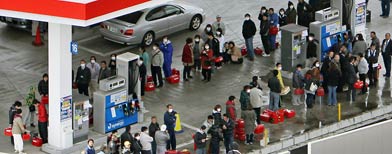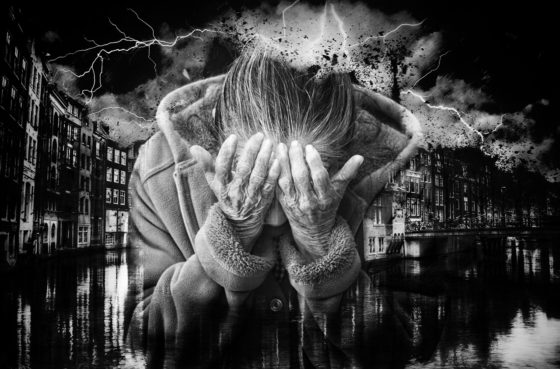
It’s been ten days since the Tsunami swept through Japan and wiped out the entire infrastructure of the North Eastern part of the island. Like the US, just-in-time delivery made essentials like food and water as easily accessible as air. But when the grid goes down in an economy so dependent on inventory management, transportation, and electronic debit transactions, all hell breaks loose. Nearly two weeks on, the people in areas affected by the Tsunami and nuclear crisis have seen little relief. Many are just struggling to survive on a few hundred calories per day.
In another time, another place, Kazuhiro Takahashi could be taken for a tramp, out scavenging for food after a long night on the bottle. In fact, he is just another hungry victim of Japan’s tsunami trying to find food for his family.
“I am so ashamed,” says the 43-year-old construction worker after he realizes he’s been spotted. “But for three days we don’t have enough food. I have no money because my house was washed away by the tsunami and the cash machine is not working.”
If his haul wasn’t so pitiful – his bag had two packets of defrosted prawn dumplings and a handful of vacuumpacked seafood sticks inside – Takahashi might be taken for a looter. But in the port town of Ichinomaki, 320 kilometres north of Tokyo, his story is disturbingly common.
Japan might be a rich country, but a week after the tsunami struck it is struggling to feed and house the victims.
“I have a place in a rescue centre in the Aka’i Elementary School, but the food they are giving us is not enough,” Takahashi says. “My parents are in their 70s and we receive a tiny bowl of plain rice twice a day, with nothing else, just a pinch of salt. We are hungry, so I have come to look for food.”
Source: The Gazette
—
Gas station queues stretching for several kilometres, long waits at supermarkets, empty store shelves and shuttered businesses have become a part of the landscape in post-tsunami Japan.
At the foot of the Mount Iwate volcano, the people of Morioka city — almost 100 kilometres (60 miles) west of the devastated coast — are still trying to adjust to the sudden absence of many things they had simply taken for granted.
At a gas station on the outskirts of the city, motorists waited hours on end before finally reaching the gas pump, clutching a 2,000 yen ($25, 17 euros) daily rationing coupon in their hands. The coupon is barely enough to buy a third of a tank on an average-sized city car.
…
“There are no more meat and vegetables. I’m eating instant meals all the time,” said Naohiko Seki. “I would like to regain my old life, but when I think about people who suffered from the tsunami, I tell myself I shouldn’t complain.”
…
Convenience stores, usually open around the clock, had row after row of empty shelves, where prepared foods like the normally ubiquitous ‘onigiri’ rice balls, water and milk products once stood.
…
“It’s really strange. The stores have almost no baby food and other items. It makes me uneasy and anxious. I am worried because I don’t know whether or not I will be able to buy what my child needs,” he said.
Source: AFP
Author Naseem Talib calls it a black swan – an extraordinary event so remote that one cannot plan or prepare for it. Donald Rumsfeld once described events in the Iraq war as “known unknowns” and “unknown unknowns.” The only thing we really do know with respect to disaster planning is that sometimes we just can’t know what to expect due to lack of available information or contemplation.
For those in Japan, even a cache of food, water, gas, and other reserve supplies would not have been enough. Many homes were simply wiped away, leaving residents with literally nothing but the clothes on their backs. In this situation, desperation sets in quickly. And without a local emergency response, or a culture of support, social norms, laws and decency can dissolve within days.
The Japanese, unlike disaster victims we’ve seen in other crisis regions like New Orleans or Haiti, have been handling themselves as well as they can, without much violence or reports of looting. Emergency responders, government and the private sector have not been completely ineffective, and have managed to keep the flow of commerce moving to those parts of Japan most affected, albeit not at the pace most would expect from a leading global player.
In Japan, ATM machines are down, and banks are closed in Tsunami areas and nuclear evacuation zones. This means that unless you had cash or something of value on your person at the time the disaster struck there is no way to acquire whatever goods are available without government assistance. Even within a technologically advanced society like Japan, however, even the basics become difficult to distribute for emergency responders and military personnel when we’re talking numbers in the millions of people.
In his book Indivisible, author Troy Grice writes of a ration-card solution that keeps commerce moving during a US dollar currency collapse. Grice wasn’t too far off in his fictional account. In response to the wide-spread regional disaster, the Japanese government has issued ration cards, which are seemingly the only viable course of action in the first world when the monetary unit of exchange, in this case the Yen, becomes unavailable.
Unlike the first few days of Katrina, where residents had no access to clean water or food, or Haiti, where gangs roamed the streets looking to loot and pillage essential supplies, the Japanese have been able to restore some of theirinfrastructure, namely food, water, limited gasoline and the sense that the country is starting to move forward.
Save a further degradation of the nuclear situation, the very worst – those initial days after crisis where families lost loved ones and food and water were unavailable – may be behind the people of Japan.
The Japanese people, it seems, have been able to hold strong. At least that’s what reports from the devastated region suggest thus far. Those who are of the ability to help have been doing so, as it is clear that the government is totally overwhelmed. Any nation whose people can respond by working together, by sharing, by comforting each other, will undoubtedly recover. Johann Hari, writes, in The myth of the panicking disaster victim, of how human beings have responded to disasters throughout history:
The evidence gathered over centuries of disasters, natural and man-made, is overwhelming. The vast majority of people, when a disaster hits, behave in the aftermath as altruists. They organise spontaneously to save their fellow human beings, to share what they have, and to show kindness. They reveal themselves to be better people than they ever expected. When the social scientist Enrico Quarantelli tried to write a thesis on how people descend into chaos and panic after disasters, he concluded: “My God! I can’t find any instances of it.” On the contrary, he wrote, in disasters “the social order does not break down… Co-operative rather than selfish behaviour predominates”.
On 18 April 1906, San Francisco was levelled by an earthquake. Much of the city collapsed, and the rest began to burn. Anna Amelia Holshouser – a middle-aged journalist – was thrown out of bed, and felt her house collapse around her. She wandered the streets, and found herself sleeping that night in the park. But then the daze wore off, and she did what almost everybody else did: she began to look after the people around her. She knitted tents out of old clothes to house all the children who had lost their parents. She set up a soup kitchen, and the local shop-keepers handed over the goods for free. Hundreds of people gathered there, as they were gathering around similar people across the city. Anna put up a sign that said: “One Touch of Nature Makes the Whole World Kin.
Hat tip Aussie Suzy, Rense.com










0 Comments